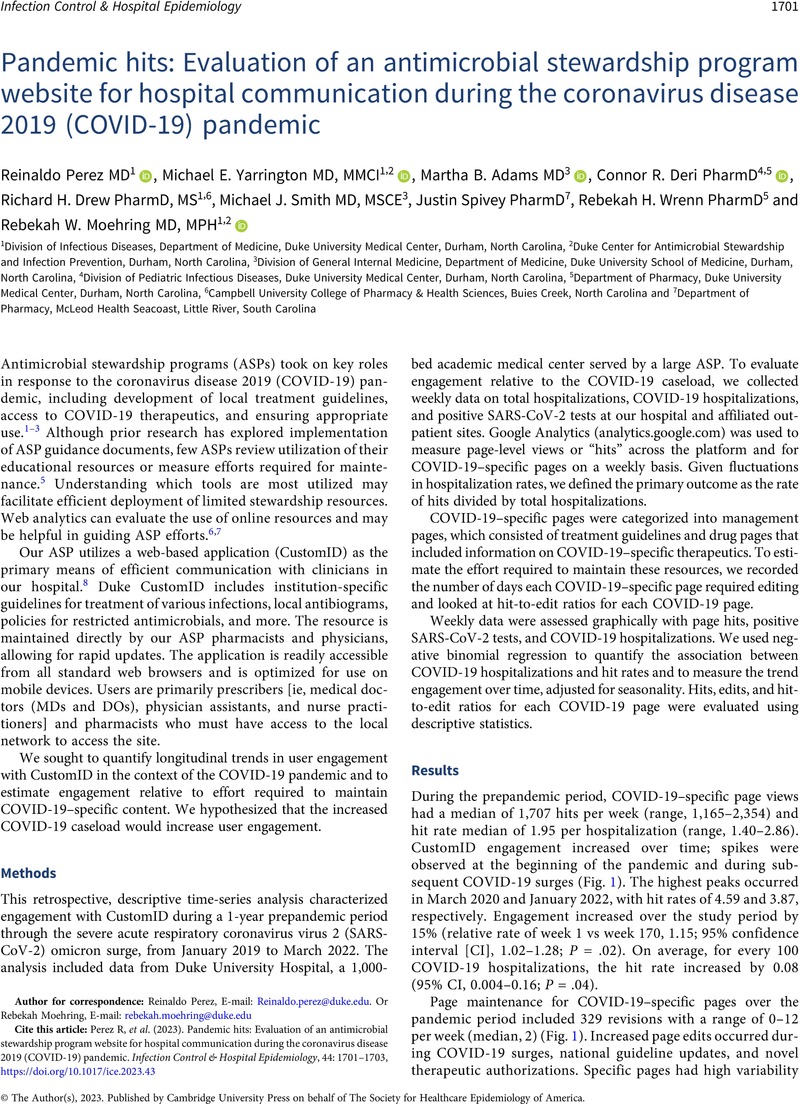No CrossRef data available.
Article contents
Pandemic hits: Evaluation of an antimicrobial stewardship program website for hospital communication during the coronavirus disease 2019 (COVID-19) pandemic
Published online by Cambridge University Press: 12 April 2023
Abstract
An abstract is not available for this content so a preview has been provided. Please use the Get access link above for information on how to access this content.

- Type
- Research Brief
- Information
- Copyright
- © The Author(s), 2023. Published by Cambridge University Press on behalf of The Society for Healthcare Epidemiology of America
References
Mazdeyasna, H, Nori, P, Patel, P, et al. Antimicrobial stewardship at the core of COVID-19 response efforts: implications for sustaining and building programs. Curr Infect Dis Rep 2020;22:23.CrossRefGoogle ScholarPubMed
Nori, P, Patel, PK, Stevens, MP. Pandemic stewardship: reflecting on new roles and contributions of antimicrobial stewardship programs during the coronavirus disease 2019 (COVID-19) pandemic. Infect Control Hosp Epidemiol 2022;43:1085–1086.CrossRefGoogle ScholarPubMed
Pierce, J, Kim, J, Deja, EN, et al. Electronic distribution of coronavirus disease 2019 (COVID-19) guidelines: a potential tool for antimicrobial stewardship programs. Infect Control Hosp Epidemiol 2021. doi: 10.1017/ice.2021.419.CrossRefGoogle Scholar
Desai, AN, Ruidera, D, Steinbrink, JM, Granwehr, B, Lee, DH. Misinformation and disinformation: the potential disadvantages of social media in infectious disease and how to combat them. Clin Infect Dis 2022;74 suppl 3:e34–e39.CrossRefGoogle Scholar
Helou, RI, Foudraine, DE, Catho, G, Peyravi Latif, A, Verkaik, NJ, Verbon, A. Use of stewardship smartphone applications by physicians and prescribing of antimicrobials in hospitals: a systematic review. PLoS One 2020;15:e0239751.CrossRefGoogle ScholarPubMed
Massanelli, J, Sexton, KW, Lesher, CT, et al. Integration of web analytics into graduate medical education: usability study. JMIR Formative Res 2021;5:e29748.CrossRefGoogle ScholarPubMed
Joshi, A, Amadi, C, Katz, B, Kulkarni, S, Nash, D. A human-centered platform for HIV infection reduction in New York: development and usage analysis of the ending the epidemic (ETE) dashboard. JMIR Public Health Surveill 2017;3:e8312.CrossRefGoogle ScholarPubMed
Duke University Hospital System. Duke CustomID. Duke CustomID website. http://customid.org/. Published July 1, 2015. Accessed January 20, 2023.Google Scholar
Stenehjem, E, Hyun, DY, Septimus, E, et al. Antibiotic stewardship in small hospitals: barriers and potential solutions. Clin Infect Dis 2017;65:691–696.CrossRefGoogle ScholarPubMed
Doernberg, SB, Abbo, LM, Burdette, SD, et al. Essential resources and strategies for antibiotic stewardship programs in the acute care setting. Clin Infect Dis 2018;67:1168–1174.CrossRefGoogle ScholarPubMed



